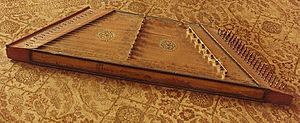Dulcimer facts for kids
The word dulcimer is used for two main types of musical instruments that have strings. Imagine a musical instrument that looks a bit like a flat box with strings stretched across it. That's often what a dulcimer is! These instruments make beautiful sounds and have been played for hundreds of years all over the world.
Contents
Discovering the Hammered Dulcimer
The word dulcimer first described a special type of zither. A zither is a stringed instrument where the strings are stretched over a flat body. This kind of dulcimer is shaped like a trapezoid, which is a four-sided shape with two parallel sides. It's similar to a psaltery, another old stringed instrument.
What makes a hammered dulcimer unique is how it's played. Instead of plucking or bowing the strings, players use small, handheld "hammers" to strike them. This creates a bright, ringing sound.
Where Can You Find Hammered Dulcimers?
You can find different versions of the hammered dulcimer in many cultures around the world. Each country or region often has its own name and style for the instrument.
Here are some examples:
- The Hammered dulcimer is popular in England, Scotland, and the United States.
- In southern Germany, Austria, and Switzerland, it's known as the Hackbrett.
- In Eastern Europe, you might hear the Tsymbaly (Ukraine), tsimbl (Ashkenazi Jewish), țambal (Romania), or cimbalom (Hungary). These can be smaller folk instruments or larger ones used in classical music.
- The Santour is played in Iran and Iraq, while the Santoor is found in northern India and Pakistan. Even though their names are similar, they are built and tuned differently.
- In Southeast Asia, instruments like the Khim (Cambodia, Laos, Thailand) and Yangqin (China) are also types of hammered dulcimers. You can also find the Đàn tam thập lục in Vietnam and the yanggeum in Korea.
Exploring the Appalachian Dulcimer
In the 1800s, in the Appalachian mountains of the United States, hammered dulcimers were not very common. People there started using the word dulcimer for a different kind of instrument. This new instrument had three or four strings and frets, which are thin strips of metal or wood on the fingerboard that help a player find the right notes.
This Appalachian dulcimer is usually played on the lap. Players often strum the strings with a pick or their fingers. It makes a gentle, folk-like sound and became a beloved instrument in the region.
Different Kinds of Appalachian Dulcimers
Over time, people created many variations of the original Appalachian dulcimer. These newer versions often added special features:
- The Banjo dulcimer has a banjo-like membrane that helps make the sound louder and gives it a banjo-like tone.
- The Resonator dulcimer has a special cone-shaped part inside that helps amplify the sound.
- The Bowed dulcimer is shaped like a teardrop and is played upright using a bow, similar to a violin or cello.
- The Electric dulcimer uses electronic pickups to make the sound louder, allowing it to be played with amplifiers and other electronic effects.


